As a contact center owner, does hiring, compensating, and supporting the workforce contribute to the majority of your expenses? We understand that it’s necessary to fulfill rising demand, ensure customer satisfaction, and deliver quality service, but you must limit those expenses to avoid increasing operational costs.
How? Through workforce optimization (WFO).
Interestingly, a big financial services company generated a whopping $6 million in savings for every 100 reassigned employees with workforce planning, a critical component of WFO.
But what is WFO, how do you master it, and how does it work in contact centers? Let’s find out!
When optimizing your call center workforce, make sure that you use robust call center software analytics to accurately check whether the staffing aligns with demands. Don’t forget to monitor the volume regularly to adjust the workforce based on changing demands.
Understanding Workforce Optimization
Workforce optimization (WFO) is the implementation of processes and strategies aimed at improving employee productivity, efficiency, and quality through strategic data application. This, in turn, helps you decrease operational costs, streamline business processes, and operate at the best level.
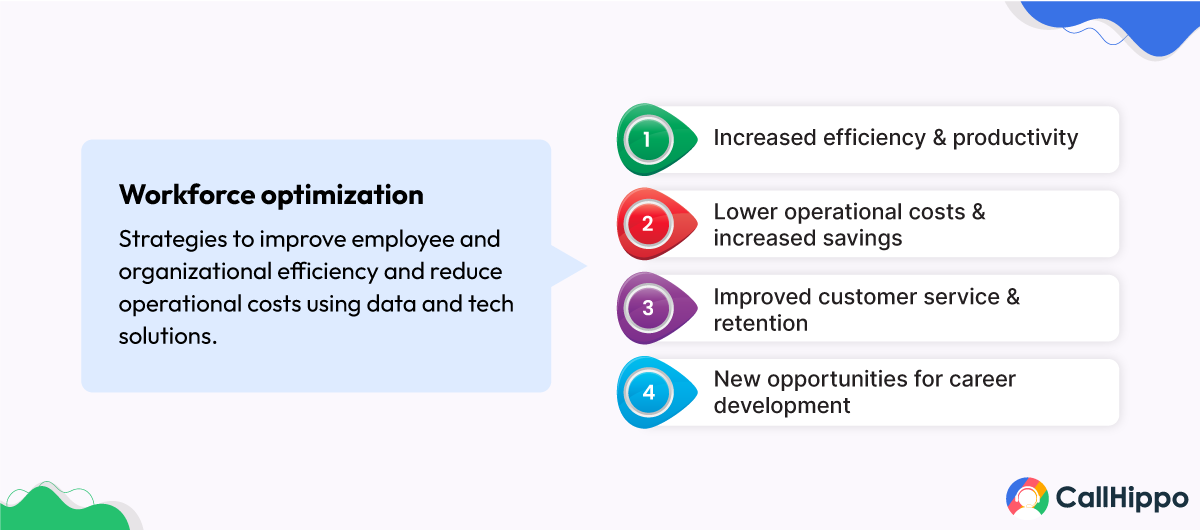
But we don’t recommend the tedious manual route to achieve workforce optimization. Why? When you optimize the workforce using proven WFO software, you maximize technology investments, experience improved customer service, enable process automation, and gain insights into each organizational aspect. The best part? You achieve all of this with minimal effort.
The primary goal of workforce optimization is operational success. This success covers increasing the work quality of employees, teams, and departments so your organization can work efficiently without incurring added costs.
WFO and workforce management optimization (WFM) are interchangeably used, which is wrong.
- WFO is a broader subject incorporating all sorts of processes and strategies to improve workforce efficiency and performance.
- In contrast, workforce management optimization has a narrower scope, comprising workforce management’s operational aspects like employee attendance tracking, task distribution, and scheduling.
4 Key Components of Workforce Optimization
To successfully optimize your workforce, you need to focus on its major components. Here are the 4 key components that complete the WFO process-
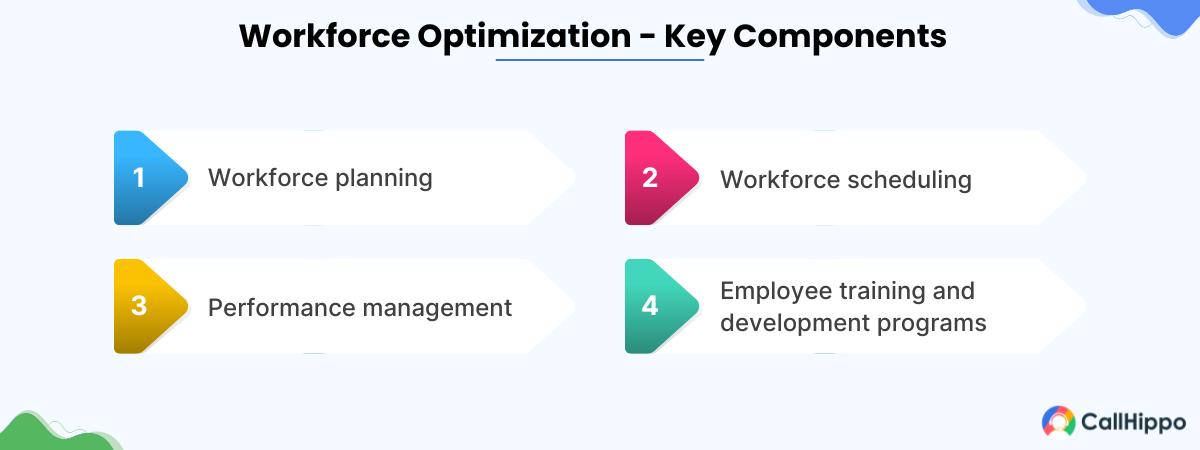
1. Workforce planning
It refers to the process of collecting and analyzing data to interpret the potential staffing demand that may arise in the future. This data is used to develop strategies and make decisions to increase or skill up the existing workforce in order to meet the staffing needs.
Workforce planning is a core component of WFO as it enables businesses to predict upcoming workforce needs based on industry or market trends and growth projections. Using data helps you to be proactive in acquiring the workforce so it doesn’t interrupt operations.
By being proactive, a financial service business saved $7.3 million, retained 94 highly skilled employees, and eliminated operational disruptions.
2. Workforce scheduling
Employee scheduling (including time and attendance management) is an indispensable part of WFO. It focuses on creating an employee schedule that covers business needs, employee availability, and peak periods or times.
The primary goal of workforce scheduling is to balance out workforce flexibility, availability, and satisfaction so that business needs are not affected.
3. Performance management
Workforce performance management is yet another indispensable component of WFO. It includes the following –
- Evaluating employee performance at work
- Comparing it to the pre-set performance standards
- Utilizing the data to give constructive feedback to employees regularly (Employees are 3.6x more motivated when you give them regular (daily or weekly) feedback)
- Setting performance and productivity standards
- Recognizing and appreciating top performers
Effective performance management helps you significantly improve overall business performance and boost job satisfaction among employees. This ultimately improves customer satisfaction, service delivery, and overall productivity.
4. Employee training and development programs
Effective training and development plan(s) help you achieve your core WFO goals. How?
- When you invest in your workforce’s professional development, their overall expertise and skills are bound to improve. Good skills help you maximize operational efficiency, a key goal of WFO.
- Investing in employee training and development programs and making efforts to improve employees’ skills builds a high-performer culture. Doing so also maintains employee job satisfaction as they seek training programs at their workplace.
7 Best Workforce Optimization Strategies
Now that you’re aware of the core components of workforce optimization, it’s time to understand the best strategies to better optimize your workforce. Let’s start –
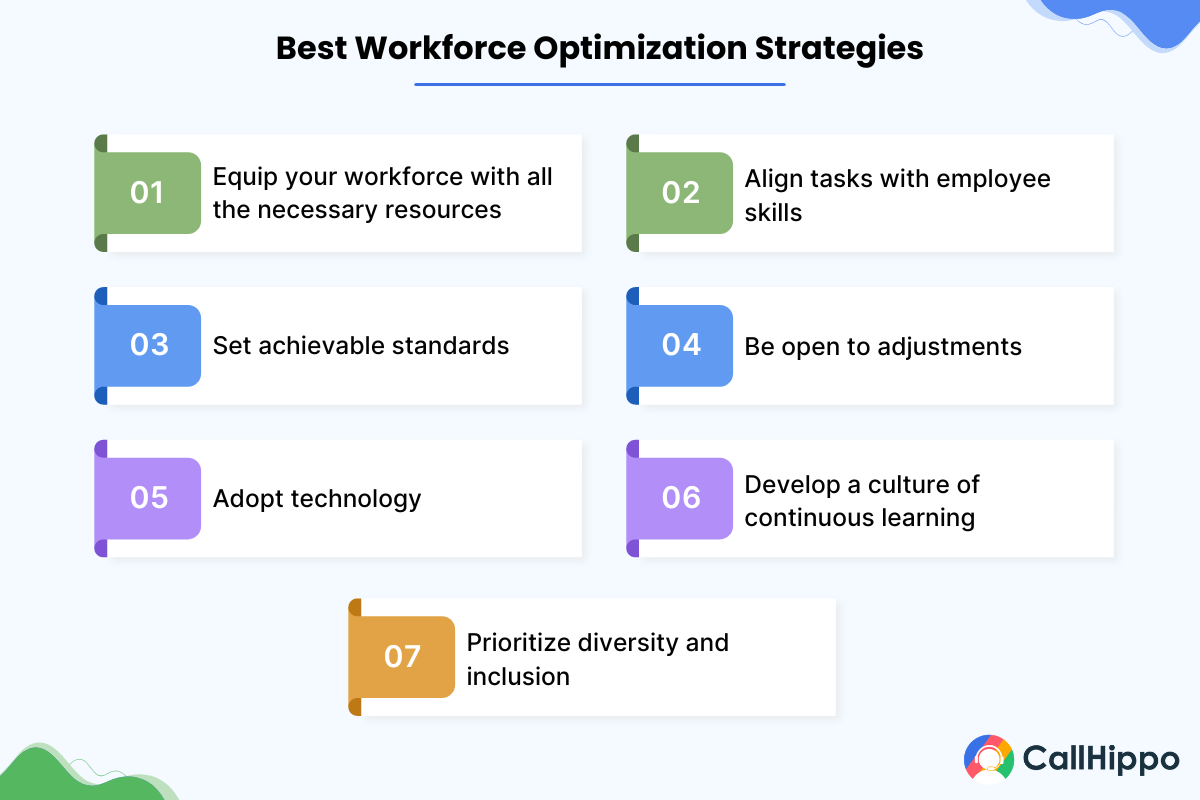
1. Equip your workforce with all the necessary resources
To ensure that your employees work with utmost productivity and efficiency (WFO goal), provide them with the necessary workforce optimization tools and resources. Some of the most useful resources are the right workforce optimization software, knowledge banks, and gamification tools.
For example, if you’re planning to launch a new product, you must train employees to sell, identify additional revenue opportunities, and upsell. This way, they can deliver the best service to customers (WFO goal). Or, if there’s an estimated increase in service queries, train your employees to handle them well to achieve high efficiency.
2. Align tasks with employee skills
Assign relevant tasks to employees based on their skills to achieve the WFO goal of employee engagement and efficiency. How? Employees have unique skills that are best for accomplishing certain tasks.
When you match skills to jobs, employee engagement, and efficiency are bound to rise.
Also, make sure that employees understand business goals and objectives and are aware of how their role contributes to the same. This helps you establish a common purpose and create a high-performing culture, driving better outcomes and employee productivity.
3. Set achievable standards
Using performance data from the right workforce optimization software, make critical decisions regarding recruitment, scheduling, and performance management. This will help you establish achievable performance standards that are reasonable for employees. In fact, setting achievable goals results in 90% better performance.
For instance, if your contact center performance data shows most agents handle 7 customer calls per hour on average, then you must set that as a standard.
4. Be open to adjustments
With growing competitiveness, staying agile with your workforce optimization procedures or rules is non-negotiable. Provide accommodating working arrangements like flexible working hours and remote working to improve employee engagement and boost workforce productivity.
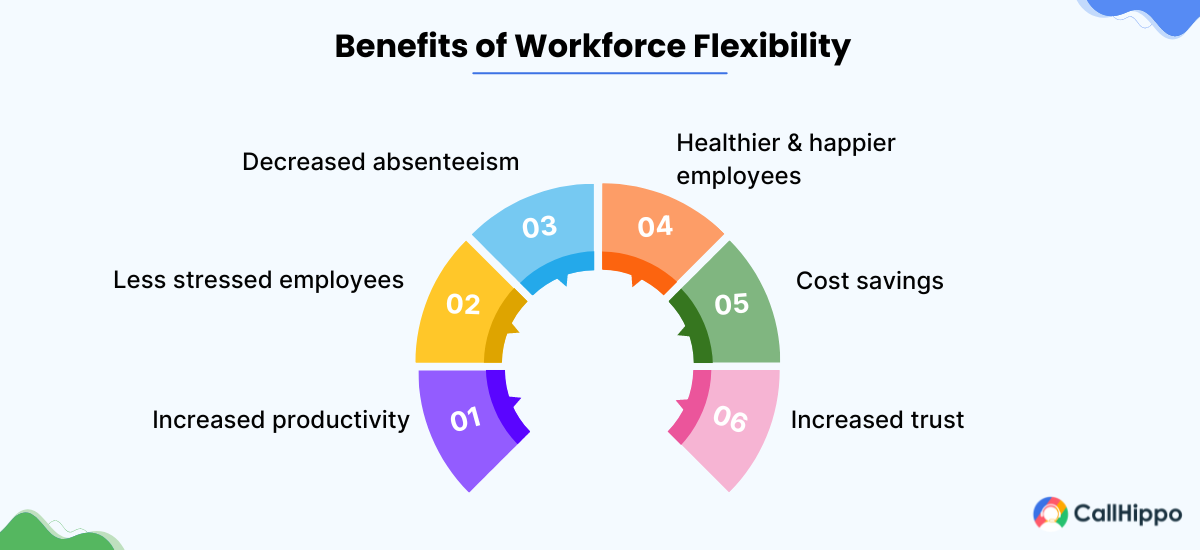
Staying agile with your WFO practices will also be helpful in case you make annual schedules. How? You can simply review and improve your annual WFO plan consistently to ensure it fulfils product, workforce, or customer needs.
5. Adopt technology for advanced workforce management
Adopting technology (including AI) enables you to streamline business tasks, enhance efficiency, and improve the bottom line.
For instance, if your contact center receives huge volumes of calls, it would be challenging for your limited team members to manually cater to each of them efficiently. However, if you adopt powerful workforce optimization software, you can simply automate processes like call distribution, forwarding, transfer, and queueing.
This will save your employees from draining time in operational tasks, and they’ll be able to manage huge call volumes efficiently.
Such software also has a call analytics feature, which helps you gain actionable insights into employee performance. Based on this data, you can take action to improve their efficiency, productivity, and performance.
6. Develop a culture of continuous learning
Optimizing the workforce will not bring results until you establish a culture of continuous improvement and learning. Why? Because such a culture offers employees psychological safety and space to make mistakes and learn without facing negative implications.
In fact, employees working at a company with a learning culture are 83% more likelier to be happy at work. They can then brush up their skills, stay updated with industry trends, and provide high value to employers who seek a competitive edge.
7. Prioritize diversity and inclusion
Having a diverse and inclusive workforce will make all employees feel welcome. This will push them to be more creative, innovative, and efficient at work.
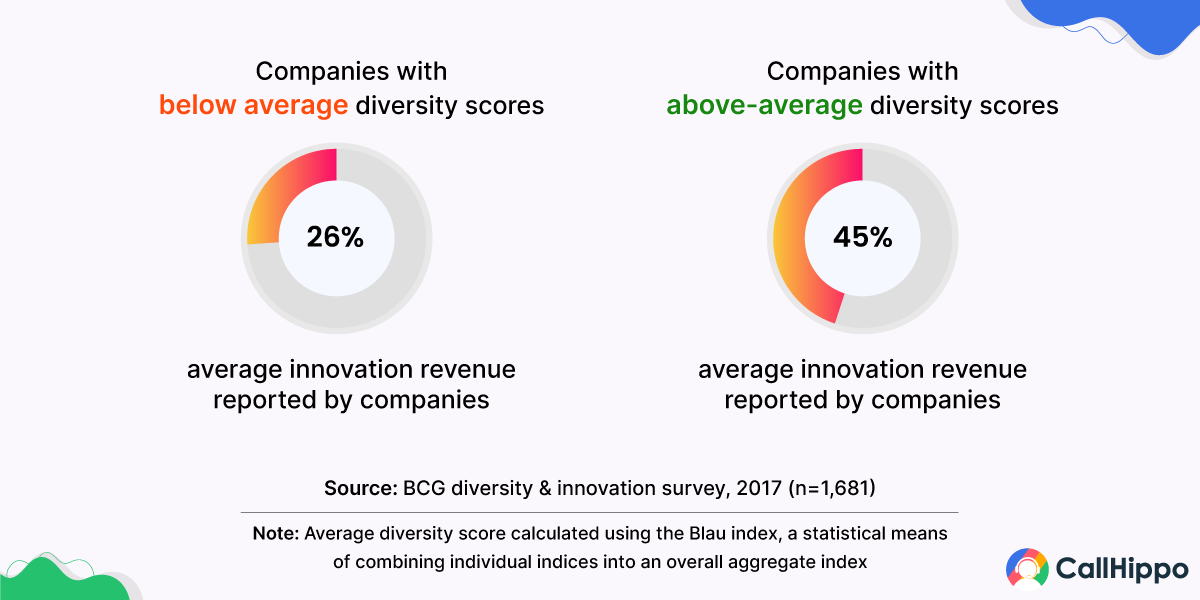
Also, companies with an inclusive workforce highly appeal to the talent pool in the market, increasing the number of candidates applying for the job. In fact, 80% of workers want to work for a company that focuses on diversity, inclusion, and equity. So, such an environment will inevitably help you onboard more skilled candidates.
Special Focus: Contact Center Workforce Optimization
Workforce optimization is applicable across industries, but it is non-negotiable for contact centers. Let’s thus discuss workforce optimization with a special focus on contact centers here.
https://webcdn.callhippo.com/blog/wp-content/uploads/2024/06/workforce-efficiency.jpg
https://webcdn.callhippo.com/blog/wp-content/uploads/2024/06/workforce-efficiency.jpg
Contact center workforce optimization refers to maximizing and managing the performance of contact center agents. It ensures that agents deliver the best performance during each customer interaction. The primary goal of contact center workforce optimization is to make your contact center agents efficient and, therefore, improve end-customer experience.
Here are the major benefits of workforce optimization in contact centers –
- WFO in contact centers involves streamlining workflows, automation, intelligent call routing, and customer service training programs. This improves contact center productivity, more so when your agents have the right knowledge and skills.
- Optimizing the workforce helps you deliver consistent digital customer experiences across customer touchpoints effortlessly. How? By integrating multiple communication channels using contact center software.
- Your cost goes down when you optimize your staff, appropriately allocate resources, and strategically streamline processes. It also empowers you to adhere to labor laws and save costs of negligence or non-compliance.
- Optimizing the contact center workforce helps you deliver great service. This, in turn, drives referrals, repeat purchases, and positive service, accelerating revenue. It also helps you gain insights into contact center agent performance that you can use to upsell or cross sell.
Now that you know the benefits of workforce optimization in contact centers, let’s move on to the WFO working mechanism.
How to Optimize Your Workforce in Contact Centers?
Optimizing the workforce in a contact center is a rigorous process. To make it easier for you, we have divided the process into three main steps –
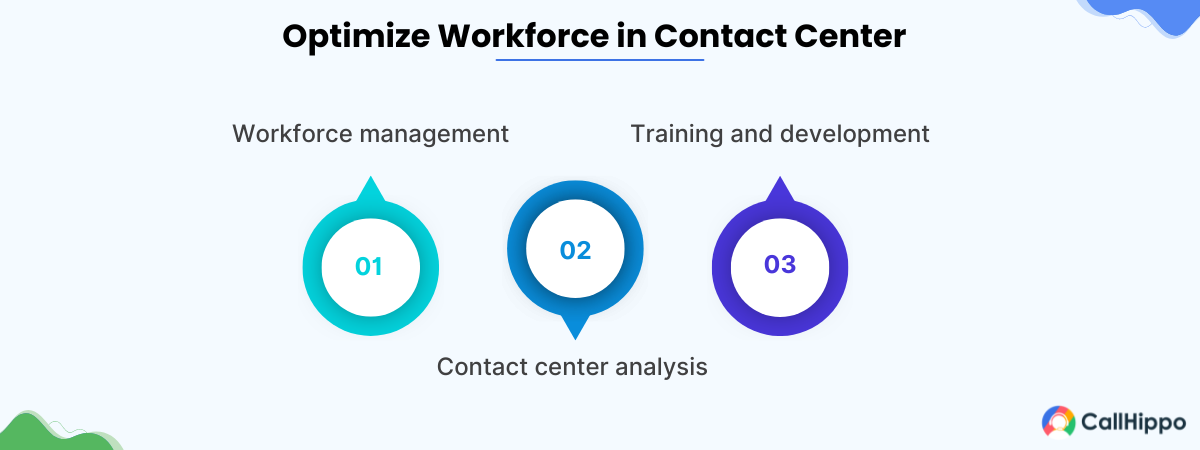
1. Workforce management
Workforce management strives to maintain a balance between workforce and workload. It does that with three simple steps – forecasting, scheduling, and performance measurements.
- Forecasting: Predict potential workforce requirements, both in terms of expertise and quantity. How? By analyzing historical and future trends, seasonal demands, and organizational rules.
- Scheduling: Develop staff schedules and task queues while considering staff availability fluctuations. Consider workload, preferences, and case severity too.
- Measuring: Monitor your employee performance and compare it with the pre-set agreements and metrics like FCR (First Call Resolution) and AHT (Average Handle Time) for better management.
Note: Workforce management is not just a random ticket assigning process. You must strategically forecast and schedule employees by utilizing contact center routing for effective workforce management. Some of the major kinds of routing that you can use are –
- Skill based routing to assign a conversation to an agent based on their unique expertise and skill.
- Priority-based routing to distribute interactions based on urgency.
- Geographic routing to direct interactions to agents from the same region or language as the caller’s.
- Time-based routing to distribute conversations based on customer time zone or agent availability to ensure instant responses.
- IVR-based routing to route calls based on customer inputs after collecting initial information.
2. Contact center analysis
This analysis is a critical part of contact center workforce optimization as it helps you make sense of raw contact center data. Under this analysis, there are two modules –
A. Text and speech analysis
Contact centers are a hub of agent data collected from agent-customer conversations. A robust contact center software can collect this data and detect patterns or trends in customer queries through AI. Its speech analytics tool helps in detecting positive or negative customer sentiments.
Using this data, you can train your workforce on how they can better manage time when interacting with customers without compromising customer service.
B. Quality management
Implementing strict quality control is another major step in the contact center WFO process. Under this process, you need to monitor and score your agents based on multiple quality and compliance areas. Some major areas are active listening, opening quality, and empathy. Doing so ensures that employees’ performance meets the quality standards at all times.
3. Training and development
To achieve workforce optimization, it’s necessary to deliver consistent upskilling opportunities This will induce job satisfaction and efficiency within your contact center agents.
These training programs boost productivity by enhancing agents’ skills, product knowledge, and customer service quality. Consider ongoing development programs like workshops and coaching to keep your agents updated with industry trends and improve their performance.
After getting an in-depth understanding of how workforce optimization in contact centers works, let’s discuss the top 4 proven strategies of the same.
Optimize Your Workforce at Affordable Rates
Get CallHippo and boosts efficiency with seamless call management & advanced analytics.
4 Best Practices for Contact Center Workforce Optimization
Contact center workforce optimization aims to adopt a customer-centric approach and achieve agent satisfaction. Here’s how you do it –
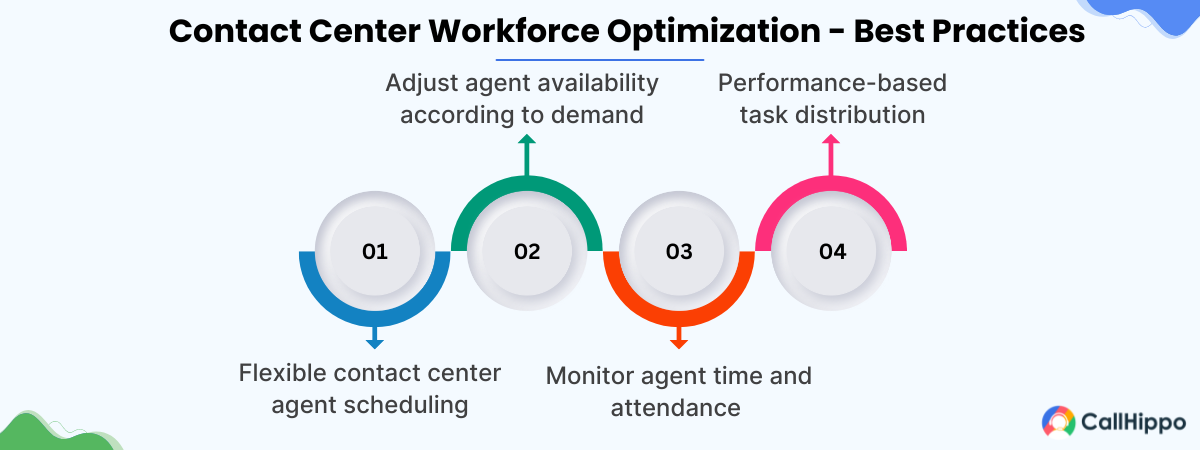
1. Flexible contact center agent scheduling
When developing agent schedules, allow some space for flexibility. This will provide agents with more control over their schedules and allow them to choose preferred shifts or exchange shifts with their colleagues. This simple strategy brings work-life balance, reduces absenteeism, and improves agent morale. All of this contributes to high workforce productivity and engagement in your contact center.
2. Adjust agent availability according to demand
Here are the best ways to align demand and agent availability –
- Adjust breaks to optimize agent availability during rush hours (high call volumes, for example).
- Gauge potential traffic after a new launch and staffing needed to cover the increased demand.
- Configure the target response times to better meet the increased demand. After making adjustments, identify the extra agents needed to align with the newly set response times.
3. Monitor agent time and attendance
This will help you set a standard availability for agents and hold them accountable. However, manually tracking every second of agents’ working hours and attendance is challenging. To make this easier, turn to AI for monitoring break compliance, schedule adherence, and agent attendance.
4. Performance-based task distribution
WFO in contact centers aim for short customer response times. To achieve this, assign customer queries to qualified agents (based on their performance). Doing so, your efficiency increases as the best agents are able to handle complex issues and provide expert support. Using these three metrics to gauge contact center agent performance:
- Customer satisfaction scores for each interaction they had with customers.
- Average handle time or the time taken to resolve a certain query.
- Quality score.
6 Future Trends in Workforce Optimization
The Call Center Workforce Optimization Software Market is changing constantly due to technological advancements and exceeding customer expectations.
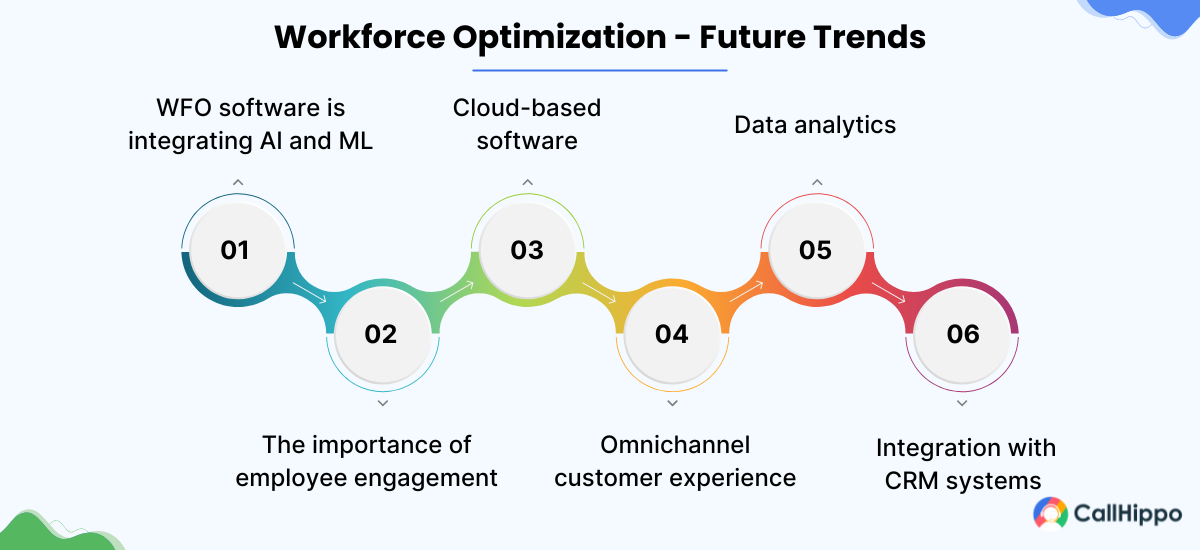
Here are the top 7 trends of workforce optimization you cannot miss –
1. WFO software is integrating AI and ML
WFO solutions are getting more intelligent and data-driven by the day. AI and ML are two major contributors. Why? Because they have the power to automate critical processes like sentiment analysis, call routing, and customer interaction analysis.
With this technology and collected data, call centers can personalize customer interactions, improve efficiency, and identify customer behavior patterns.
2. The importance of employee engagement and satisfaction is rising
Employee-centric WFO software is in trend in the business sector. The core reason is that employee engagement and satisfaction are critical for decent call center performance. Also, WFO software is increasingly coming up with advanced features to improve employee engagement, like performance analytics, gamification, and training modules.
With this one-point focus on employee satisfaction, call centers have been experiencing better agent performance, elevated customer experience, and lower turnover rates.
3. Cloud-based software is the new normal
Such solutions are on the rise because of the cost-effectiveness, flexibility, and scalability they offer. After all, they enable call centers to level up or tone down their operations whenever needed without investing a fortune in expensive tangible infrastructure.
With this Cloud-Based Business Communication Solutions, call centers are able to allow agents to work from home or their desired location, adding to the flexibility.
4. Call centers are focusing on omnichannel customer experience
There’s a rise in the number of companies focusing on and investing in the omnichannel experience from 20% to more than 80%. So, contact center or WFO software is now coming with integrated omnichannel capabilities so call centers can manage interactions across all channels in one place.
This facilitates a friction-free experience across all the available channels, driving higher customer loyalty and satisfaction.
Bonus: Find out all about the omnichannel contact center here.
5. Data analytics is becoming important for WFO
Due to the rising importance of data analytics, WFO and contact center software are integrating advanced analytics to offer valuable insights to call centers like customer satisfaction levels, call volumes, average handling time, etc.
With this data, call centers will be able to optimize their workforce, make data-driven decisions, and elevate overall performance.
6. Integration with CRM systems is significantly increasing
CRM is critical for call centers looking forward to transforming their customer interactions. So, the workforce optimization solution is increasingly integrating with CRM to enable agents to access interaction history and customer data and provide personalized service.
With this integration, call centers are finally able to monitor and analyze customer conversations across different platforms to level up the customer experience.
Wrapping Up
We have finally reached the end of this extensive guide on workforce optimization strategies, benefits, and trends. Now, you’d have a better understanding of the essence of workforce optimization and the components it comprises. Here, you must note that optimizing your call center’s workforce is daunting due to the series of steps and management involved.
But not when you bank upon the mentioned strategies and robust contact center software like CallHippo to transform your workforce’s efficiency and reduce operational costs. Its cutting-edge technology truly elevates your customer service, streamlines communication, and improves customer satisfaction.
FAQs
1) What is the difference between workforce optimization and workforce management?
WFO incorporates all the processes and strategies to improve workforce efficiency and performance. In contrast, WFM comprises workforce management’s operational aspects like attendance tracking, task distribution, and scheduling.
2) How can workforce optimization software benefit my business?
The three major benefits that WFO software brings into your business are higher efficiency, cost-saving, and better quality and compliance with minimal effort.
3) What are some effective strategies for contact center workforce optimization?
All the effective strategies for contact center workforce optimization are explained above. The three major ones are performance-based, adjusting agent availability with demand, and monitoring employee time and attendance.
4) How do AI and machine learning influence workforce optimization?
AI and ML speed up and improve the workforce optimization process by automating operational tasks, offering precise demand forecasting, and facilitating efficient scheduling. All of this improves employee satisfaction and operational efficiency.

Subscribe to our newsletter & never miss our latest news and promotions.









